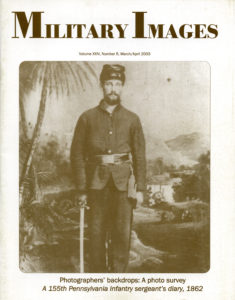The complete issue
Vol. XXIV, No. 5
(40 pages)
Print edition: Visit our store to check availability
Digital edition: Visit JSTOR.org to purchase
Subscribe to MI
Explore the MI Archives: Browse | Advanced search | Tutorial
Inside
Cover image
An image from the David Scheinmann collection pictures a Union soldier standing in front of an elaborate backdrop.
Table of Contents (p. 1)
Mail Call (pp. 2-3)
Feedback includes kudos for the 1872 officer’s dress coat and a question about the source for information on the story of Henry C. Kelly. Both articles appeared in the last issue.
Passing in Review (pp. 4-5)
Eight publications are listed, including Storming Little Round Top (Da Capo Press) by Philip Thomas Tucker, Lee’s Tar Heels, the Pettigrew-Kirkland-MacRae Brigade (University of North Carolina Press) by Earl J. Hess, Grand Army of the Republic: Civil War Veterans, Department of Massachusetts, 1866-1847 (Heritage Books, Inc.) compiled by A. Dean Sargent, Culp’s Hill at Gettysburg (Thomas Publications) by John M. Archer, The Civil War in Photographs (Carlton Books) by William C. Davis, Fort Clark and Brackettville: Land of Heroes (Arcadia) by William F. Haenn, A Soldier’s General, The Civil War Letters of Major General Lafayette McLaws (University of North Carolina Press) edited by John C. Oeffinger and Civil War Artillery at Gettysburg (Da Capo Press) by Philip M. Cole.
Photographer’s Backdrops: A Photo Survey (pp. 6-25)
Painted backdrops, according to William C. Darrah’s landmark book Cartes de Visite in Nineteenth Century Photography, are credited to European photographer A. Claudet in 1851. Examples of American and international military portrait photography include almost endless variations, of which 100 are shown here. They span the Civil War through World War I and are grouped by Benton Barracks camp-type, other camp-type, scenic, rivers, nature, studios, Civil War era foreign, post Civil War, 20th century, and World War I foreign. Identified images include Joseph A. Rummel of the 72nd Ohio Infantry, William H. Fisher of the 70th Indiana Infantry, James J. Dyer of the 26th Kentucky Mounted Infantry, Austin Moson of the 5th Indiana Cavalry, Donald McCullough of the 116th Pennsylvania Infantry, George Stevens of the 8th New Hampshire Infantry, a portrait inscribed “Mr. C.J. Haller, Alta, Ill.,” L.F. Norton of the 14th Ohio Infantry, Alonzo H. Stickney of the 4th Maine Infantry, Joseph N. Morris of the 7th Rhode Island Infantry, Asst. Surg. Nicholas H. McGuire, U.S. navy, Robert G. Huston of the 118th Illinois Mounted Infantry, Frank Leeland and Frank Vail, U.S. Marine Corps.
The First to Fall by Michael Hammerson (p. 26)
1st Lt. Henry B. Hidden of the 1st New York Cavalry holds the grim distinction of being the first cavalry officer from the Army of the Potomac killed in action during the Civil War. His story is told here.
The Diary of John H. Irwin, 155th Pennsylvania Volunteer Infantry by Scott Irwin (pp. 27-32)
Excerpts from Irwin’s diary are illustrated with his portrait and those of fellow soldiers Thomas D. Thomas, J.H. Bilson, Naoh H. Pagburn, Samuel Kilgore and James Strong. Previously unpublished, the diary dates from Sept. 7, 1862, through Sept. 23, 1862.
Uniforms & History by Michael J. McAfee (pp. 33)
In “155th Pennsylvania Volunteer Infantry,” McAfee explores the Zouave uniform worn by the members of the regiment. The text is illustrated with a portrait of an unidentified soldier from the 155th.
Corliss Is Back! By Chris Nelson (pp. 34-35)
The author’s ongoing search for relics related to Augustus Corliss continues with the discovery of a cache of images. Five photos are featured here, including three portraits of Corliss, one image of him in his tent and another of him with his son and daughter in Cuba.
Two Alberts at 2nd Winchester by Mike Fitzpatrick (pp. 36-37)
Albert C. Burd of the 67th Pennsylvania Infantry and Albert C. Harbough of the 6th Maryland Infantry were both captured at the Second Battle of Winchester. They eventually rejoined their commands. They however would not survive the war. Harbough was mortally wounded in the Wilderness and Burd died on the front lines of Petersburg on March 25, 1865.
Sutler’s Row (pp. 38-39)
The Last Shot (p. 40)
A quarter-plate tintype from the collection of Dennis Hood pictures a group of soldiers perched on the famous overlook at Lookout Mountain.



































